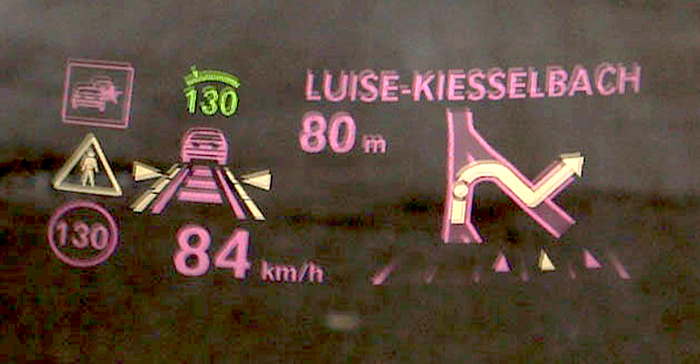Why Inspection Is Crucial for Windshield Head-Up Display Clarity
There is much more to reflecting a Head-Up Display image than meets the eye.

Head-up displays (HUD) are an increasingly common feature on new vehicles as carmakers seek better ways to convey information to drivers in a non-distracting fashion.
The HUD’s ability to show drivers navigation and speed information without diverting their gaze to an in-dash display is their primary appeal. Emerging augmented reality applications make head-up displays even more valuable.

The Audi Q4 e-tron's augmented reality Head-Up Display highlights the car ahead and provides navigational turn information.
However, their ability to provide that information depends directly on the quality of the image reflection off the inside of the windshield. This is trickier than it seems because a windshield is not a solid piece of glass. Instead, it is two layers of glass surrounding a plastic “wedge” layer that provides occupants with protection from glass breakage.
Because of the multiple layers, multiple reflections are created, producing a blurred, curved, or double-imaged picture. To ensure those problems are minimized, inspecting windshields assigned to HUD duty is critical.
Radiant Vision Systems, of Redmond, Wash., is a leading provider of test and measurement solutions for the automotive industry. They partner with Grainger, Indiana’s CP Systems to produce complete windshield testing rigs that are used by both windshield makers and HUD projector manufacturers to ensure the accuracy of their products before they are delivered to automotive OEMs for installation in new cars.

“When you have these multiple layers, you end up with refraction for each surface area,” explained Andrew Early, CP Industries controls engineer. “HUD glass is a windshield that has a taper inside of the two panes. What that taper does is it takes these four images and it brings them all together into one image,” he said.
Radiant’s ProMetric imaging colorimeters and photometers feature an electronically-controlled lens that identifies and focuses on the HUD image that is projected into infinity. This capability lets ProMetric analysis software accurately measure luminance and chromaticity at any working distance, according to the company.
CP Industries integrates these camera systems with its test fixtures to create a complete windshield testing solution. “When we started out it was having one camera measuring one position and determining these three measurements, the ghosting, distortion and the rotation,” recalled Early. “Then it developed into, ‘Now I need three positions, give me three cameras’ and it kept progressing: more specifications, more details.”

Those early rudimentary systems tested 10-13 different inspection points in windshields. Now, CP Industries’ 6-axis robot arm with Radiant’s photometric Y-Series camera examines 18 inspection points with 40 inspections at each point.
With this rigorous inspection procedure, glass and HUD projector companies can confidently deliver their products to carmakers, ready for installation. This should ensure that as we rely on HUDs to provide vital safety information through augmented reality that we’ll get the clear image that the engineers intended.
About the Author(s)
You May Also Like





